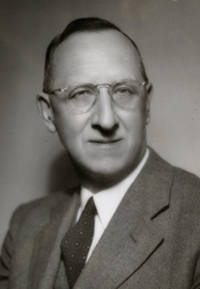Wesleyan's Tenth President
 |
James L. McConaughy1925-1943 "A college should always be stable, but never standing still." |
James L. McConaughy was only 37 years old when he was elected to the presidency of Wesleyan University but he arrived on campus with prior administrative experience as president of Knox College in Galesburg, Ill. Born on October 21, 1887, in New York City, he graduated from the Mt. Hermon School and from Yale University. After teaching English and education at Bowdoin and Dartmouth colleges, where his skill in public speaking was well known, he was elected president of Knox in 1918.
When he was elected president of Wesleyan six years later (he assumed the office in February 1925), he brought his educational philosophy to campus. He believed that a college president should teach classes and he felt that athletics were "real preparation for the game of life." Gifts of almost $1.2 million were announced at the conclusion of his inaugural address and he used the money for building projects. He supervised the construction of the "Cage," officially known as the Alumni Athletic Building, which was used until 2004 for men's and more recently, women's, basketball.
Other buildings constructed during his tenure include Hall Laboratory, Olin Library, Shanklin Memorial Laboratory, and Harriman Dormitory. The old library was then remodeled and became the '92 Theater (now the Patricelli '92 Theater). A very successful Centennial Celebration was held during his tenure.
McConaughy believed strongly in the honor system ("the finest flower of student responsibility") and in individual initiative. He introduced new courses in the arts. Intercollegiate events-athletics, singing, debating, and forums-were very popular. During this era between the two world wars, students had more freedom and more responsibility than previously.
In September 1942, McConaughy was granted a leave of absence to become president of United China Relief, and in April 1943 he resigned after 18 years as president of Wesleyan. Active by then in Republican politics, he served as lieutenant governor of Connecticut from 1939 to 1941 under Governor Raymond Baldwin, an alumnus of the class of 1916.
When McConaughy ran for governor several years later, in an ironic twist, his opponent was Wilbert Snow, the poet and Wesleyan professor of English, whose lectures, often considered radical, McConaughy had had to defend to Wesleyan trustees. McConaughy, for whom McConaughy Hall, fondly known as Mocon, the scene of freshmen dining, was later elected governor of Connecticut and served from 1947 until he died in office on March 7, 1948.
